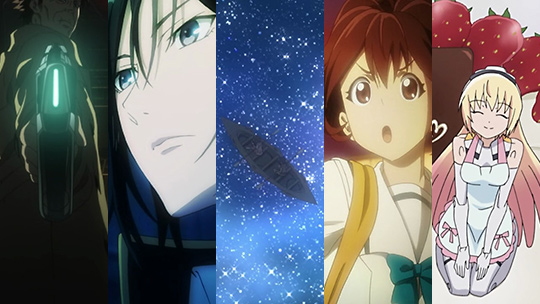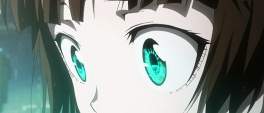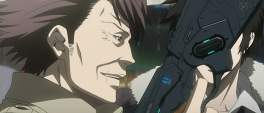
Already no stranger to delving into the future, anime this season sees Production I.G. produce two forward looking series with Psycho-Pass, a mid-future cyber-noir and Robotics;Notes, a close-future hyper-commercialised world of robot fetishism. A1-Pictures meanwhile adapts the far future Shinsekai Yori (From the New World) novel into a series, followed by newcomer studio 8bit adding a TV series to Busou Shinki's already voluminous roster of media and merchandise. Finally there is the alternate history and fantasy-leaning K from GoHands, best known for their recently completed movie trilogy Mardock Scramble. All of them take a stab at a high-concept future but if the first three episodes are anything to go by, some are more successful than the others.
Psycho-Pass for instance takes the dystopian world of Philip K. Dick's Minority Report - where law enforcement is no longer a reactive element of government - while mixing in some of Brave New World's deliberations on a ruthlessly enforced gilded cage. It tackles the same ethical briar patch as Minority Report: whether it is just to pre-emptively arrest, or in this series' parlance "rehabilitate", someone based upon the prediction of a third party, in this case the omnipresent Sybil System. Human judgement is taken out of the equation with even the gloriously titled "Dominator" guns unable to fire without the system's say so.
This leaves only the act of pulling the trigger up to the investigators, one of whom is the clueless and wonderfully androgynous rookie Akane who on her first assignment shows she is unwilling to blindly accept the decisions of the all-knowing network. This question of free-will is the central theme of Psycho-Pass so far: when a machine constantly monitors you, coercing your diet, boiling down your emotions to a mathematical coefficient and deciding the future that would make you the "happiest", what decisions are left but the most mundane and trivial? When outliers and creative thinkers are defined as criminals, what hope is left for imagination? It's fertile ground for science fiction and with a strong creative team behind it with an eye for details (like a caduceus symbol brandished by the investigators) the series looks like it has the chance to explore what it means to be enthralled to technology.
That topic is one that Shinsekai Yori turns on its head; set a thousand years in the future after the Earth has been irrevocably changed by an outbreak of people with immense psychic powers, it isn't the technological utopia one thinks of but a return to nature and isolationism. Instead of brandished cellphones and interfacing with networks the young teens are taught about the onset of minor psychic powers, or "cantus", a clear analogy for puberty if there ever was one. The opening episodes are a jumbled hodge-podge of back-story and scene setting, with the first building a quiet sense of dread, the second opting for a Harry Potter-esque sports day while the third seems set to continue the trend with an homage to Race for Your Life, Charlie Brown before pulling the rug out from all that world building. Sinister foreshadowing and muted hues are replaced by an iridescent gelatinous beast that claims it is a sauntering computer library of all mankind's knowledge. So whereas Psycho-Pass pitches technology as the reigns of an unflappable dictator, Shinsekai Yorishows it as a salvation from the dark-ages style ignorance and religious fervour. This furtive approach to the taboo and the tantalising possibilities it could open up is indicative of a series that already has an intriguing concept and execution.
A shame that Production I.G.'s other series, the excruciatingly punctuated Robotics;Notes, isn't similarly engaging. Taking the robot fetishism that Japan is stereotypically known for and loosely hangs a story around it, the protagonist du-jour (thanks Hyouka) is a lethargic and cripplingly uncharismatic male who is partnered with a spunky go-getting female. Their mission: to complete the bipedal giant robot languishing unfinished in an abandoned hangar. Were this the only thread, the plot arc would be uninspiringly predictable but hints of a greater story including a blood-red aurora borealis and a mysterious girl with a glowing power symbol on her forehead afford a smidgen hope for the remainder of the series which thus far has been disappointingly rote. Story aside however and the reverence paid to all aspects of robotics, both fictional and real, is heartening and captures the starry eyed wonder that once seemed to be only a few years away. The assistive lower-body exoskeleton of a convenience-store owner is introduced without fanfare and sets the scene for a Robot Wars style sporting event for hobbyists as well as the foreshadowed completion of the meta-anime inspired giant robot. Like Asimo though, all of this exists in a hyper-commercialised bubble, with the blatant product placement of Calpis competing Skal Water to the innumerable in-world advertisements seen when the lead duo travel to Tokyo. Robotics;Notes posits a world where robotics are back in vogue and the financial bar for them has been lowered, but this is nothing compared to Busou Shinki (literally Armament God Process) which takes the wish-fulfilment fantasy of jointed figurines coming to life to its logical next step. The series itself is just another entry in the model and video game release cycle that kicked off in late 2006 and spearheaded the mecha musume resurgence. Initially featuring three such dolls and their "master", a fourth quickly joins their ranks and immediately has an existential quandary over her role as a fighting machine versus her domesticated house mates.
If you ascribe to "cute girls doing things" as a genre, the first three episodes are just a paint-by-numbers. In this case though the cute girls are scantily clad and fifteen centimetres tall which is supposed to make dynamic chores such as cooking and cleaning extra adorable. Instead, these cyberpunk faeries are drenched in all manner of fluids, most of them white, and subject to a cavalcade of compromising positions including a sapphic and squeal filled bath scene; the social standing of the high-school freshman with a polygamous four of these dolls is perhaps wisely unexplored in the first three episodes. If there is a saving grace to this saddening vision of the future it is the sporadic battles which sees the glassy-eyed pixies don absurd (yet still revealing) armour to knock seven shades of tar out of one another. This is usually portrayed by the budget saving set-up of fireworks butting heads but the 3D CG still affords some dynamic if overly brief shows of pugilism. K then, the final future-facing show, is all too happy to put its combat front and centre, beginning like Psycho-Pass and Robotics;Notes with a flash-forward, this time with a stand off between the smartly suited blue team and the punk aesthetic red team. Swords and magic powers sit alongside widescreen tablets and monorails in a setting that feels like a tame session of Shadowrungot a little out of hand. Excess is what defines the first three episodes though which sees a softly spoken white haired teen chased through a pseudo-futuristic Tokyo by a skateboarding thug and modern-day samurai, replete with gonzo camera work and colour grading that may as well have been applied by a four year old who just discovered her favourite colour was blue.
That extravagance carries over to a woeful portrayal of females; of the two XX-chromosome cast members, both are gifted back-problem breasts and are gratuitously ogled in the opening, while one wears a skirt short enough to be a belt and the other is entirely naked and runs around the school campus for a whole episode. The story fares little better with a heavy reverence paid towards Durarara, with colour coded street gangs and even a blonde bartender, but talk of kings and ruling Japan immediately invokes Air Gear. All flash and no substance means K's rare knack for comedic timing is all the stranger with its charmingly obnoxious cleaning robots and slapstick beatings for its most reserved characters seemingly coming out of nowhere. None of these series offer what could be called a realistic vision of our future, instead using the indeterminate future as a way of contextualising their concept. Be that pervasive technology as a shackle in Psycho-Pass and liberator in Shinseki Yori, the fetishism of robotics in Robotics;Notes or robot fetishes in Busou Shinki or just soft-fantasy with warriors and psychics wielding laptops alongside katanas in K. The benefit of science fiction is being able to address contemporary issues with what-if scenarios and though Psycho-Pass and Shinsekai Yori are the runaway winners in that capacity, the pulpy entertainment-first ethos of Robotics;Notes and K have their place too, leaving Busou Shinki then to languish in the sex-bot slums to service the predilections of a few.















